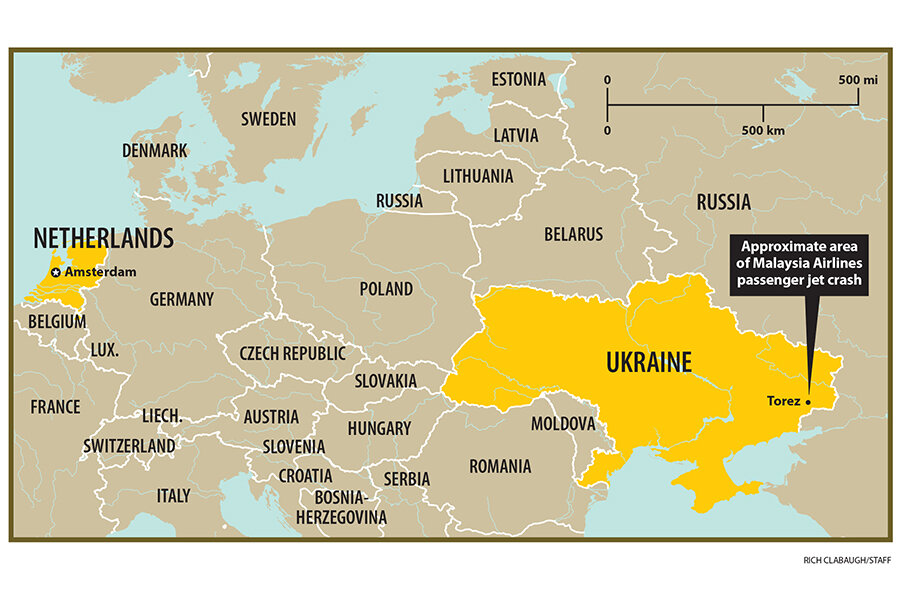Malaysia jet tragedy: How do airlines traverse war zones?
Loading...
| New York
Before Malaysia Airlines Flight 17 was likely shot down over eastern Ukraine Thursday, apparently by a Russian-made missile, aviation officials from Europe and the United States had already been issuing a flurry of warnings to commercial airlines, as well as adjusting flight restrictions and no-fly zones as Russian separatists increasingly began to take their fight to the skies.
Indeed, the flight path of the doomed civilian jetliner, a Boeing 777 en route from Amsterdam to Kuala Lumpur, had already been restricted twice by Ukrainian authorities this month. On July 1, Ukraine told airline pilots not to fly below 26,000 feet over the region.
But on Monday, officials raised the no-fly area up to 32,000 feet, more than six miles above the ground, after another Russian-made missile took down a Ukrainian military cargo jet flying at 21,000 feet, officials said. Flight 17 was flying at 33,000 when it was shot down, killing all 298 people on board, officials say.
Since then, EUROCONTROL, which regulates European air traffic, has rejected all flight plans crossing the area, and Ukraine has declared the entire space a no-fly zone.
Still, it is not uncommon for commercial civilian airliners to fly over restive, war-torn regions, including those in Afghanistan, Iraq, and other parts of the world, experts say. And Flight 17 was flying in a well-traversed route.
“This was a very commonly used route and passenger jets fly at high altitudes over many of the world's hotspots all the time," said Norman Shanks, an aviation security expert at Coventry University in the UK. “They chose the most direct and economic flight route possible, which keeps their fuel costs down and is something we expect as customers. They were no different from any other international airline.”
Nearly 290 commercial flights continued to operate over the war zone, with only 10 diverted flight plans in recent weeks, according to EUROCONTROL. These included major airlines, including British Airways, Air France, and Lufthansa, who were among those using the same route over eastern Ukraine, according to FlightRadar24.
On Thursday, these also included a Singapore Airlines passenger plane that was flying just 15 miles away from Flight 17 when it was shot down, as well as 55 other civilian jets that flew through the war zone the same day, according to reports.
And experts say that if airlines avoided every war zone around the globe, flight times would be extended, requiring extra pilots as well as fuel – making certain routes too expensive for passengers. And since jets typically fly at higher altitudes over such regions, the risk of being targeted by sophisticated surface-to-air missiles is remote, experts say.
“There has never been an airliner shot down from a surface-to-air missile at this kind of altitude,” said John Cox, an air-safety consultant and former crash investigator, to the Wall Street Journal. “The threat has always been a shoulder-fired missile from insurgents," which experts say typically cannot target jets flying higher than 15,000 feet.
Which is why aviation officials had only issued warnings to commercial airlines with flight plans over Ukraine – including the region where officials say Russian insurgents likely shot down Flight 17, using a Russian made SA-11 missile, which can operate at an altitude of up to 70,000 feet.
In April, US Federal Aviation Administration officials did issue restrictions on flights over Crimea, just south of where Flight 17 was shot down. But the federal agency had only issued a “special notice” to airlines and pilots flying over the rest of Ukraine, telling them to "exercise extreme caution due to the continuing potential for instability."
The U.N.'s International Civil Aviation Organization also warned governments in April that there was “the possible existence of serious risks to the safety of international civil flights” over Ukraine.
On Friday, most airlines had stopped flying over Ukraine.
Aviation experts warn the tragedy could reverberate through the industry as airlines become more vigilant about the safety of their flights over war-torn regions, diverting flights hundreds of miles, adding time and cost to hundreds of routes. These costs will lead to higher fares for passengers, many experts say.








